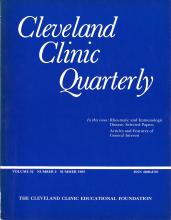ABSTRACT
Cryoglobulins are immunoglobulins or immunoglobulin-containing complexes that spontaneously precipitate and form a gel at low temperatures and become soluble again when the temperature is raised. There are distinct types: single monoclonal proteins (type I), mixed cryoglobulins with a monoclonal component (type II), and mixed cryoglobulin’s containing only polyclonal components (type III). Chemically, these proteins are not significantly different from their noncryoprecipitating counterparts; their cryoprecipitability is related more to electrostatic interactions and solubility than to structure or nonprotein composition. Many cryoglobulins are immune complexes. In addition to serum, they can be found in other physiological fluids as well as tissue and have been shown to occur in a wide variety of diseases. Their presence in tissues such as the kidney, vascular structures, and synovial fluid may be related to the pathogenesis of that disease. Serum concentrations of cryoglobulins can be reduced through the use of drugs, plasma exchange, and plasma filtration.
- Received April 1984.
- Accepted March 1985.
- Copyright © 1985 The Cleveland Clinic Foundation. All Rights Reserved.






